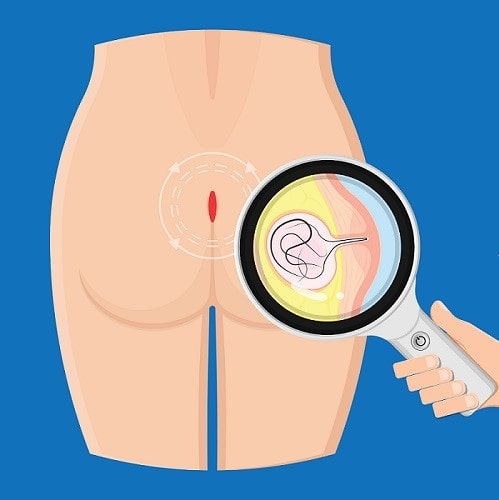
Pilonidal Cyst

A common condition, which for many patients remains taboo even today, is the pilonidal cyst. A pilonidal cyst is a particularly annoying condition, which causes embarrassment to the patient but no health risks.
What is a Pilonidal Cyst?
A pilonidal cyst, or hair follicle fistula is a cyst under the skin at the end of the spine in the mesogluteal region, which contains hair and skin debris. It ranges in size from a small dimple to a large painful mass.
Essentially, the hairs in the area get trapped inside the skin and form a cyst that can then become infected.
The condition can be chronic or in an acute phase, so it needs immediate treatment.
 «70,000 people every year experience problems with pilonidal cyst»
«70,000 people every year experience problems with pilonidal cyst»
Pilonidal Cyst: Appearance Causes
The exact cause for the formation of a coccyx cyst is not known.
Although in the past it was believed that the pilonidal cyst was a congenital pathological condition, today experts believe that the disease is acquired and is due to ingrown hairs, causing an infection in the skin. Sedentary life, skin friction for various reasons such as tight clothing can push hairs into the skin.
Many factors have been identified that increase the likelihood of developing a pilonidal cyst, some of which are:
- Hair growth in the area
- Sedentary lifestyle
- Deep gluteal fold
- Obesity
- Chronic irritation of the area
- Family history
In some cases it can appear without the presence of all the above-mentioned factors.
 «Shaving in the area of the intergluteal fold, with a razor, is blamed for the appearance of the pilonidal cyst»
«Shaving in the area of the intergluteal fold, with a razor, is blamed for the appearance of the pilonidal cyst»
Who does the Pilonidal Cyst affect?
A pilonidal cyst affects people of all ages and both sexes, however it seems to affect men more, but that doesn't mean it doesn't occur in women.
According to epidemiological data, the condition affects 26 people per 100,000 population at an international level.
Risk factors
The pilonidal cyst can appear in anyone, however there are some population groups that have higher chances such as:
- Men, who appear to be 3 to 4 times more likely to develop a coccyx cyst than women.
- Teenagers and people up to 40 years old.
- Workers in occupations that require long hours of sitting, such as truck drivers and office workers.
- Obese people, where the skin folds more easily.
- People with heavy hair growth and thick, hard body hair.
 «During World War II the disease was called "Jeep driver's disease"»
«During World War II the disease was called "Jeep driver's disease"»
Pilonidal Cyst: Initial Stage
The pilonidal cyst in the initial stage may be very small and show no symptoms, so it is not noticed by the patient. You may feel a little swelling or some discomfort, especially when sitting.
Pilonidal Cyst: Symptoms
The symptoms of a coccygeal cyst range from mild, like a small dimple in the area, to very severe.
When the skin around the cyst becomes infected and an infection develops it becomes painful and you may be able to feel:
- Pain
- Skin irritation and swelling
- Discharge of fluid from the bladder
- Foul smell from the drainage of pus
Σε σοβαρότερες περιπτώσεις η κύστη κόκκυγος μπορεί ακόμη να προκαλέσει:
- Fever
- Motion sickness
- Weakness
Pilonidal Cyst: Diagnosis
The diagnosis of pilonidal cyst is made during a clinical examination. The doctor will ask you about your symptoms, if the cyst has changed in appearance, if it is draining fluid, if you have ever had a fever, and will assess the area.
Visual examination is usually sufficient to diagnose a pilonidal cyst. Blood or imaging tests are not necessary.

Read also...
Pilonidal Cyst: Treatment
Evaluating the situation, the severity of the symptoms you present, if you have faced a similar situation in the past, etc. the doctor will recommend the best treatment for your case.
Treatment for pilonidal cyst is individualized and options are evaluated taking into account the severity of the disease as well as the lifestyle of the patients.
Management of a pilonidal cyst includes simple procedures performed in the doctor's office, as well as surgical removal.
Depending on the characteristics of each case, treatment may include:
- Opening and drainage of the cyst, which relieves the patient in acute cases. The procedure is performed in the office with local anesthesia.
- Antibiotic medication, which can treat the inflammation, but not the cyst.
- Chronic, complex cases are treated with surgery, which is carried out in several ways. The recto-anal surgeon will explain to you which one is suitable for dealing with your own case.
Skin care is very important after any operation Depending on the operation technique, the surgeon will give instructions that you must follow until the wound heals.
Prevention
By following simple habits in our daily life you can avoid the pilonidal cyst to a significant extent. More specifically, by removing the hair and keeping the area dry and clean, avoiding and maintaining a healthy weight, you greatly reduce the chances of developing a pilonidal cyst.
Depilation and keeping the area clean is essential in both the acute and chronic form of the disease, as it prevents the formation or recurrence of cysts.
Alexandrite Laser hair removal at regular intervals determined by the doctor will prevent the hairs from penetrating the skin, causing inflammation, while creating, at the same time, a clean environment where the growth of microbes is not favored.

Frequent Questions
Where does the pilonidal cyst appear?
The pilonidal cyst appears at the end of the spine, in the so-called "urissa".
How is the pilonidal cyst created?
A pilonidal cyst is created by hairs present in the area that grow inward and become trapped in the skin causing infection.
How should I sit when I have a pilonidal cyst?
By avoiding sitting for a long time on hard surfaces and generally limiting your sedentary life, you reduce the possibility of developing a pilonidal cyst.
How can I tell if I have a pilonidal cyst?
Only the specialist doctor can confirm this for you, as the symptoms vary between patients, while at the same time they also resemble symptoms of other diseases such as perianal fistula or perianal abscess.
Can a pilonidal cyst be malignant?
A pilonidal cyst is considered a benign condition. A few cases, which had been left untreated for many years, have been reported as cancerous.
Is it safe to monitor the pilonidal cyst instead of removing it?
Yes, in people without discomfort, regular monitoring is perfectly safe.
Is anesthesia required in case of surgery?
In the vast majority, operations are performed only with the use of local anesthetic.
Are there alternative (non-surgical) treatments?
Other treatments such as laser cauterization or destruction of the pilonidal cyst by injection of solutions are offered, but there is insufficient data to evaluate their effectiveness for this and at Facemed, we do not recommend them.
Is there a chance of cyst recurrence after surgery?
Yes. If the predisposing factors do not change then there is always a risk of a cyst reappearing.
Bibliography
- https://fascrs.org/patients/diseases-and-conditions/a-z/pilonidal-disease
- https://www.ncbi.nlm.nih.gov/books/NBK557770/
- https://www.toplinemd.com/advanced-surgical-physicians/blog/top-8-facts-about-pilonidal-disease/
- https://www.pilonidal.org/what-is-pilonidal-disease/faq-diagnosing
